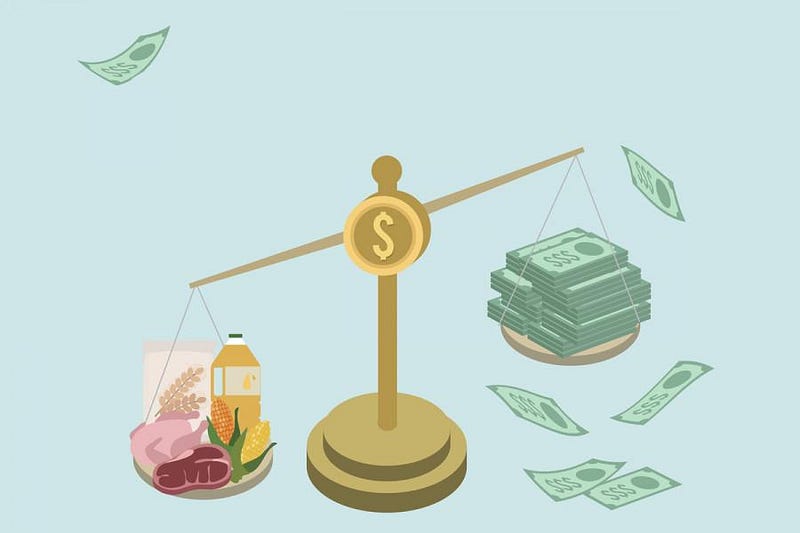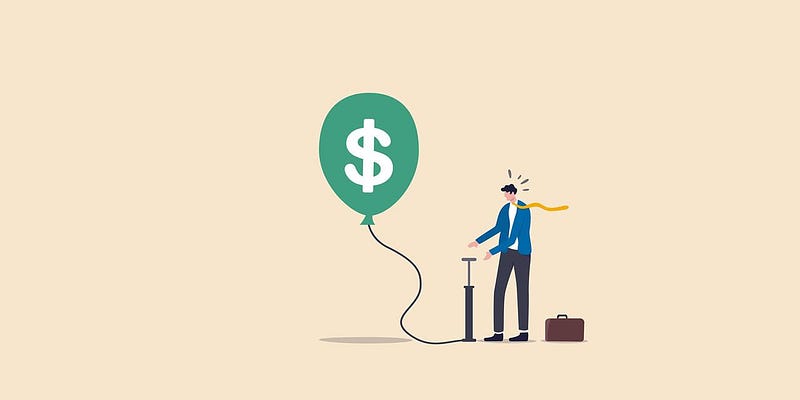Inflation — Good or Bad?
It is safe to assume that everyone agrees that the last few years have been challenging for citizens of the world. From frightening global…
It is safe to assume that everyone agrees that the last few years have been challenging for citizens of the world. From frightening global warming news to a deadly pandemic that halted normalcy to widespread protest over systematic racism, and now with the ongoing war, and price hikes — humans have been through a lot.
The current rate of inflation has been a defining aspect of the COVID-19 recovery. Prices are on the rise and people are becoming more and more unhappy. The value of a dollar now may not be the same tomorrow. As a result of the Covid-19 crisis during the previous two years, many businesses have had to cut back on output or perhaps close down. While we await the dawn of a new day and expect everything to return to normal, economies are still fighting to recover and meet the demands of many. This crisis has wreaked havoc on the global supply chain in an instant.
Inflation 101
Inflation may be summed up in four words: Broad Increase In Prices. The International Monetary Fund (IMF) defines inflation as the rate of increase in price over a particular period. One of the most common terms in economics, inflation is a wide measure of price increases or increases in the cost of living in a country. It can, however, be calculated more precisely for some goods and services. Inflation measures how much more money must be paid for a specific set of products and/or services over a given period of time, usually a year.
Inflation is associated with a loss of purchasing power of each unit of currency over time, increasing the cost of living for consumers which means that customers pay more for petrol, a gallon of milk, or a haircut. When we compare the value of the dollar today with the value of it yesterday, we can see that inflation has lowered its worth. As the price rises, money buys less, and this instance is referred to as a fiscal drag.
Why now?
Many people are puzzled and may not comprehend why costs are rising at such an alarming rate. Since the 1980s and 2008, this is one of the worst inflations the world has seen. And, while the most logical explanation is that it is mainly due to the war, this is not the case. Sure, the war has contributed to inflation to some extent, but it is not entirely responsible for rising costs. This goes back to the fundamentals of economics: the supply and demand theory.
When demand goes up, the price goes up as well. When demand is low, prices fall. In contrast, when supply is high, prices go down. And when supply is short, prices go up.
Soaring prices are emerging as a hallmark of the pandemic-era recovery around the world, driving prices to rise even further. When lockdowns were imposed in March 2020, and the pandemic paralysed the economy driving it into free fall, many firms were forced to close or reduce working hours. Consumers stayed at home as a health precaution and employers cut a staggering 22 million jobs. In the April-June quarter of 2020, economic output fell at a record-breaking 31% annual rate. Companies had to slash investments and postpone restocking while everyone anticipated more misery.
Instead of plunging into a long slump, the rollout of vaccines in March of last year restored consumer confidence, allowing them to return to restaurants, bars, and stores, as well as travelling. The economy roared back, driven by massive infusions of government money and emergency intervention in the hopes of boosting the economy. Businesses had to hustle to meet demands overnight. This unexpected rise in demand hasn’t given the economy enough time to recuperate and produce enough goods to meet the demand. They couldn’t fill job vacancies quickly enough, and they couldn’t acquire enough supplies to keep production going. As business picked up, ports and freight yards couldn’t handle the busy traffic. Global supply chains seized up.
Companies discovered that they could pass on increasing costs to consumers in the form of higher pricing, as many of whom had managed to save a significant amount of money during the pandemic. This is how and why most products have increased in price.
Because now the supply is short, and demand is high.
How Hard Inflation Hurts the Poor
It is terrible but not surprising, that the poor are going to be the victims of this inflation zeitgeist at a level that hasn’t been seen in decades. This time, the rising costs have taken a greater toll, increasing the cost of living for the poor in rural areas far more than for those with higher incomes.
Inflation disproportionately impacts lower-income and middle-class Americans, according to research conducted in the United States. According to a global poll conducted by the World Bank and the International Monetary Fund, people who identify as extremely poor are 10.5% more likely to name inflation as a top national concern than those who identify as rich. Growing inflation is also linked to rising poverty rates, according to the study.
One significant key contributor to the poor becoming victims is that they belong to the socio-economic group that has the most difficulty purchasing a property. The majority of the lower-income group lives on rent, and real estate prices are rapidly rising as a result of a mix of rising demand and constrained supply. Even if individuals strive to live in more affluent areas to increase their economic mobility, rising rents will eat up a big portion of their earnings.
A large portion of the very little savings that the poor have are spent on essentials. A disproportionate fraction of their assets is in pure cash, which, as previously stated, has little potential for price appreciation and is heavily hit during inflationary periods. Because their disposable incomes are also far smaller, they lack assets, investments, and even cryptocurrencies, all of which could otherwise help them improve their situation.
War and Inflation
War, as history has shown, brings nothing but chaos. Aside from the unnecessary loss of human lives, war involves major economic costs, including infrastructure destruction, a decrease in the working population, inflation, shortages, uncertainty, increased debts, and disruption of normal economic activity. Inflation rose in the United States during World War II because the economy was reaching capacity, excessive government spending, and a labour shortage created inflationary pressures. Economies may face cost-push inflation due to shortages of goods and services, and increased prices of basic commodities such as oil during the war. Whenever a country is devastated by war and its capacity to produce goods is drastically curtailed, hyperinflation can happen as governments hastily print money to make up for the shortage of goods. In 1946, for example, Hungary and Austria saw the greatest rates of hyperinflation on record due to crippled economies.
Because major conflict has the potential to threaten supplies, war often leads to higher oil prices. Oil and gas prices have risen since Russia invaded Ukraine in 2022, resulting in increased global gas prices. Economic sanctions against Russia in response to the invasion will limit supplies and put upward pressure on gas prices as Russia is a major supplier of oil and gas. For several reasons, this war is expected to be highly inflationary for the rest of the world and the following are just to name a few:
Federal deficits would increase
In general, wars cause inflation. Wars necessitates a huge amount of money to hire, transport, arm, and feed troops. Purchases of guns, ammunition, and military equipment are also part of military engagements. Additional expenditure for a conflict in Ukraine will surely increase the federal deficit, not in a way that will make the economy more productive in the short or long term.
Monetary policy would have to ease
Governments have to issue more Treasury bonds to fund the war and to keep debt payment costs low, the Federal Reserve will have to keep interest rates low. In the event of a crisis in Ukraine, the Federal Reserve would be even more hampered from raising interest rates or cutting Treasury bond purchases. The Federal Reserve will have to ease monetary policy hence, placing more inflationary pressure on the economy.
Energy prices are likely to rise
Oil and natural gas prices usually rise substantially when wars erupt, as armies consume massive amounts of oil. Oil prices soared sevenfold from $25 per barrel in September 2001 to $140 per barrel in September 2008 throughout the early 2000s, when the US attacked Afghanistan and then Iraq. Furthermore, Russian natural gas and oil may cease to flow to Europe, increasing energy prices in Europe and, to a lesser extent, around the world. Rising energy costs are self-evidently going to exacerbate inflationary pressures, and this is especially true when one of the players happens to be one of the world’s largest exporters of oil and natural gas.
Shortages would probably worsen
A war would not only increase aggregate demand for energy but also semiconductors and many other items. For example, if the US military intervened in Ukraine, Americans may have to wait much longer to buy a car that is not being produced right now because of a chip shortage.
Food prices could increase
Since natural gas is a key ingredient in fertiliser production, it will be troublesome if natural gas prices rise further as a consequence of decreased Russian natural gas exports during the war. Due to increased natural gas costs in Europe, fertiliser prices more than doubled in 2021. Fertiliser prices could rise higher if a war breaks out in Ukraine, prompting farmers not to plant on their marginal acreage at a time when grain supplies are already at record lows. With fewer acres under cultivation, less grain is produced, leading to an increase in global food costs. It could also result in more food shortages.
U.S. dollar could depreciate
If the US decides to impose harsh financial sanctions on Russia, such as kicking it out of the SWIFT system for global electronic payments, it will not only cause problems for Russia but also cause inflation in the US. Russia would have to sell its products in currencies other than the US dollar if the SWIFT system did not exist. As a result, nations like China and Germany, which currently buy Russian energy exports in dollars, would no longer need as many dollars in their foreign reserves. Furthermore, decreasing demand for US dollars could lead to a depreciation in the US currency rate, making imports more expensive in the US. In the worst-case scenario, Russia’s exclusion from SWIFT might spur other countries to establish their payment systems, further undermining the dollar’s position as the world’s reserve currency.
Malaysia’s inflation rate could grow by 2% this year from its current level, attributed to the higher crude oil and gas prices, amid concerns of a global economic shock from Russia’s invasion of Ukraine. Rising energy prices will aggravate the slump in Western nations, putting downward pressure on Asian export growth this year. With all of that said, it is possible that war or no war, the world may face chronically high inflation in the future years. Nonetheless, it is undeniably true that all else being equal, a conflict in Ukraine will exacerbate inflation, and potentially a lot worse, for the reasons highlighted above.
Malaysia’s Reaction to the Inflation
Prices of everyday commodities have risen in Malaysia in recent months, and certain markets are already experiencing shortages of items such as eggs and chickens. This situation is beginning to have a considerable impact on Malaysian household consumption, and with limited government aid, many are turning to charity for food. Some experts predict that this hardship would manifest itself in a spontaneous street demonstration, with flash mobs being promptly dispersed by authorities. Food security is a big worry for people, and there appears to be no comprehensive governmental strategy in place to address the issue. Economists believe this inflation is yet another aberration caused by economies reopening after two years of intermittent restrictions. The world is experiencing a severe bout of inflation, and Malaysia is particularly vulnerable due to the Ringgit’s poor performance against the US dollar over the last 12 months.
Aside from food, current oil prices have risen dramatically from USD 20 per barrel in 2020 to over USD 70 per barrel by the end of 2021 and USD 90 per barrel by February 2022. As businesses scramble to get back on their feet, the supply chain has been severely disrupted, resulting in a tenfold increase in expenses in the previous year.
According to statistics, Malaysia’s inflation rate went up 3.2% in December of last year, with food and transportation bearing the most pressure on the consumer price index (CPI). However, the government’s initiative to reopen almost all economic and social sectors has paid off, as indicated by the 3.1% GDP growth recorded in 2021.
Another issue that drew a lot of attention is the country’s minimum wage. The absurdly low minimum wage of RM 1200 is probably making Malaysians feel the impact of inflation more acutely. Because Malaysians are poorly underpaid, this unavoidable occurrence has added to their strain of carrying on with their daily routine while trying to stay afloat financially. Datuk Baljit Singh, vice-president of Bank Negara, highlighted the situation, saying that increasing the minimum wage is not a step in the right direction; it is comparable to exacerbating the inflation problem by driving consumer prices even higher.
Inflation is nothing new; fortunately, our country has a long history of price stability. The current price increase, which is being fueled by a disruption in global and regional supply chains, is a mild occurrence. This inflation is not the result of a significant increase in demand or a period of rapid economic expansion that puts a lot of pressure on wages and salaries. This situation has given us the chance to resort to long-term measures to address probable causes of supply shortages, such as artificial scarcity or market structures and rigidities. The government along with economists are constantly devising new strategies to combat inflation, but the standard policy response frequently includes price restrictions, liberalisation of imports to alleviate supply shortages, tax reductions, and increased domestic food production for the people. The government’s most recent move to open up borders for international travel may help to moderate inflation by encouraging foreigners to visit Malaysia and contribute to the country’s economic growth.
Inflation is all bad, right?
Bad may be a strong word to describe inflation. Inflation can either be good or bad depending on the circumstances. Many believe that hyperinflation — the rapid price increases — is a bad thing. Hyperinflation can destabilise political systems, turn the middle-class into paupers and the poor into homeless people overnight, and make it impossible for businesses to keep up. Lenders and individuals on fixed incomes, such as students and retirees, can be hit hard by inflation. For employees bringing home paychecks, whether inflation is a good or bad thing hinges on what happens with the wages they receive. In a high-inflation environment, if a worker’s compensation increases faster than prices, they may still be better off.
However, looking on the bright side, this inflation is an indication that the economy is resuming its regular course. Businesses just need some time to re-establish themselves and generate enough goods and commodities to meet the demands of many. When the economy is not operating at full capacity, which means there is unused labour or resources, inflation can theoretically help enhance output. More money means higher spending, which corresponds to more aggregated demand. An increase in demand means there is more production required to supply that need. In this setting, inflation is contributing to the recovery of the economy, and before long we will soon be back to normalcy.
[Written by: Balvin Dhaliwal. Edited by: Miza Alisya.]






